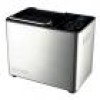DeLonghi DBM450 Owner Manual - Page 19
Liquid, Yeast
 |
View all DeLonghi DBM450 manuals
Add to My Manuals
Save this manual to your list of manuals |
Page 19 highlights
Liquid Some form of liquid is essential; usually water or milk is used. Water produces a crisper crust than milk. Water is often combined with skimmed milk powder. This is essential if using the time delay as fresh milk will deteriorate. For most programs water straight from the tap is fine, however, on the rapid one-hour cycle it needs to be lukewarm. • On very cold days measure the water and leave to stand at room temperature for 30 minutes before use. If using milk straight from the fridge do likewise. • Buttermilk, yogurt, sour cream and soft cheeses such as ricotta, cottage and fromage frais can all be used as part of the liquid content to produce a more moist, tender crumb. Buttermilk adds a pleasant, slightly sour note, not unlike that found in country style breads and sour doughs. • Eggs may be added to enrich the dough, improve the color of the bread and help to add structure and stability to the gluten during rising. If using eggs reduce the liquid content accordingly. Place the egg in a measuring cup and top up with liquid to the correct level for the recipe. Yeast Yeast is available both fresh and dried. All the recipes in this book have been tested using easy blend, fast action dried yeast which does not require dissolving in water first. It is placed in a well in the flour where it is kept dry and separate from the liquid until mixing commences. • For best results use dried yeast. The use of fresh yeast is not rec- ommended as tends to give more variable results than dried yeast. Do not use fresh yeast with the delay timer. If you wish to use fresh yeast note the following: 6g fresh yeast = 1tsp dried yeast Mix the fresh yeast with 1tsp sugar and 2tbsp of the water (warm). Leave for 5 minutes until frothy. Then add to the rest of the ingredients in the pan. To get the best results the yeast quantity may need to be adjusted. • Use the amounts stated in the recipes; too much could cause the bread to over-rise and spill over the top of the bread pan. • Once a sachet of yeast is opened, it should be used within 48 hours, unless stated otherwise by the manufacturer. Re-seal after use. Resealed opened sachets can be stored in the freezer until required. • Use dried yeast before its use by date, as the potency gradually deteriorates with time. • You may find dried yeast, which has been manufactured especially for use in bread machines. This will also produce good results, though you may need to adjust the quantities recommended. 18















